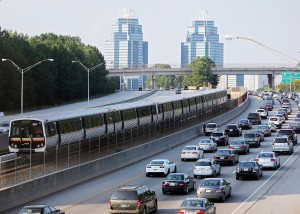Built Environment Analysis – Exterior: Dunwoody Marta Stations

In the city of Atlanta known for diversity, there is one common word that everyone seems to understand and that is, “traffic”. If you are like-minded to the vast majority of the population then you strongly dislike the notion of sitting bumper to bumper to a complete strangers for 2 hours a day on your way home from an 8 hour work day. Well, I was on the verge of experiencing that exact predicament. Luckily, my route brought me South down Hammond Drive and to my left was a monstrous structure that look as if six football fields were stacked on top of one another to form a parking deck. This was the Dunwoody Marta Station and public transit would soon save my day. I sat patiently at the red light, waiting for the countless pedestrians to cross the street and soon was granted ability to turn left and slowly approach the entrance gates.

As I approached the gates of freedom, I pushed the button for a ticket and entered. Funny how, as a commuter it costs money to partake in these amenities but exterior factors such as the sunlight and cool-face numbing winds were able to enjoy the “interiors” free of charge and welcome their charm, or lack of, to anyone in proximity. The arms raised and I soon instinctively started to follow the white painted arrows around and around until open spots trickled into vision.
I exited my vehicle and I quickly heard the ear piercing screech of metal grinding to a halt. It was the MARTA train and my enemies of red lights, pedestrians and security gates lengthened my trip just enough to miss the train. I knew that I now could walk calmly towards the railways since I had time before the traffic skipping bus screeched yet again into the waiting area below. I barely squeezed into the next available elevator and the doors shut. Holding my breath and unable to reach into my pocket due to the capacity of users, I desperately tried to not think about how we were more than likely reaching the weight limit, if not, well over. Luckily, a few moments later, the doors opened. I exited first and with a laugh, I thought to myself how there might be one thing worst that being stuck in rush hour traffic and that is, being stuck in an elevator with complete strangers.
I was finally on the last leg of my journey to the train as I heading towards the waiting area. It seemed as if everyone was still in the working mindset. There were benches to be sat on, but everyone still insisted on waiting while standing. I guess subconsciously they believed it would help lessen the wait time if they were up and ready as the train approached. Once again, I shrieked as the “nails on a chalkboard” approached from the distance and just like that a somewhat empty train was stormed by commuters and soon escaped into the distance. Instantaneously, countless public transit users escaped the dreaded afternoon horror of rush hour, while the rest of the inhabitants of the city sat in traffic.




